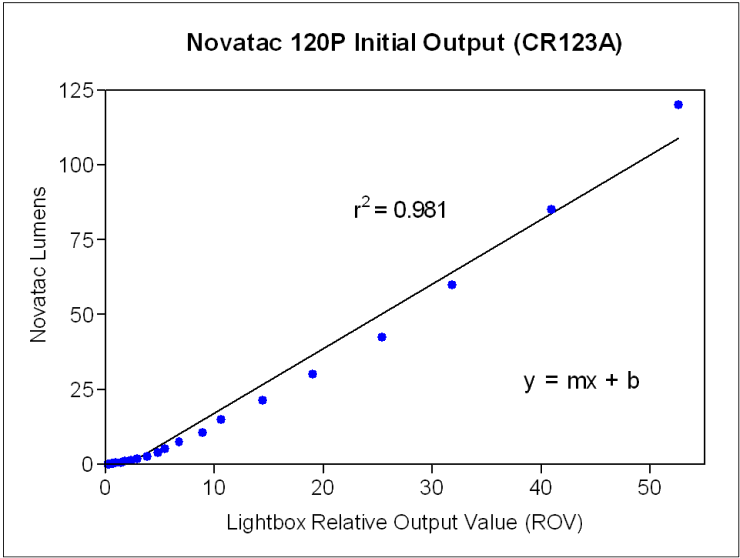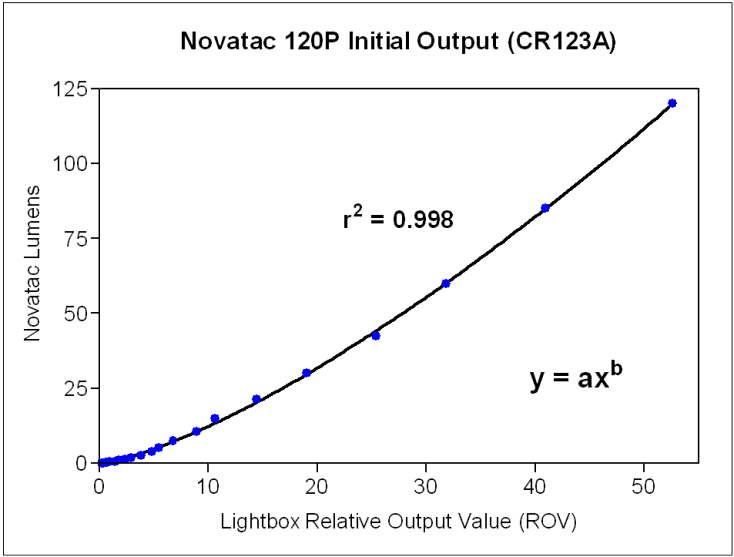1xCR123A/RCR Round-up Review: RUNTIMES, BEAMSHOTS, & more - UPDATED!
REVIEWER'S NOTE: This is my first round-up review of my 1xCR123A/RCR lights, similar in format to my Multi-stage 1xAA - Part IV, 2xAA and Thrower round-ups.
For a discussion of the color rendition properties of different emitters and tint bins, please see my comparison thread: Color Rendition and Tint Comparison: Cree, Rebel, GDP, Nichia
Warning: this post is very pic and text heavy!
UPDATE June 10, 2009: Added Olight Infinitum I10 to the review
UPDATE APRIL 30, 2009: Added Romisen RC-N3 II to the review
UPDATE JANUARY 1, 2009: Added Dereelight C2H to the review
UPDATE OCTOBER 17, 2008: Added EagleTac P10C and Olight T10 to the review
The contenders:
From left to right: EDGETAC NiteCore Extreme, Fenix P2D, Horus FD-1.3 Titanium, JetBeam Jet-II IBS, Lumapower D-mini Digital and Incendio, Novatac 120P, Surefire E1B Backup.
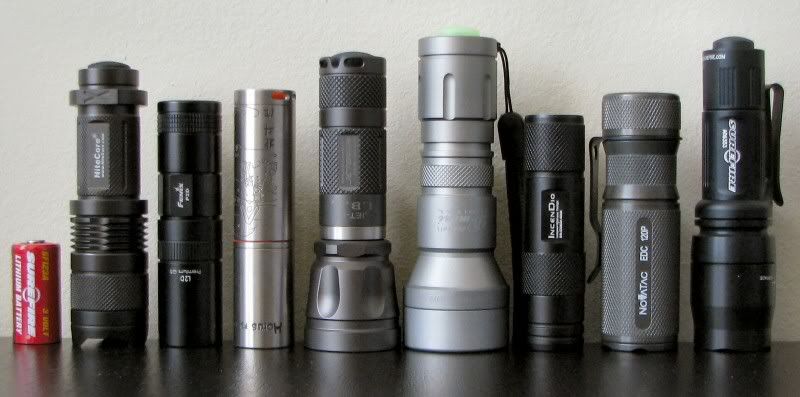

Additional lights: Spartanian II, NiteCore EX10 Cree Q5 and GDP, ITP C9,Olight T10, Eagletac P10C, Dereelight C2H. Not shown are the Romisen RC-N3 II and Olight I10.
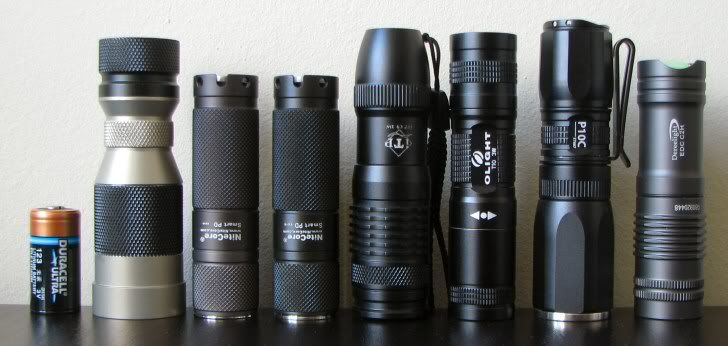

For a comparison pic of the Jet-II PRO, scroll down to my detailed discussion section.
Testing Method: All my output numbers are relative for my home-made light box setup, a la Quickbeam's flashlightreviews.com method. You can directly compare all my relative output values from different reviews - i.e. an output value of "10" in one graph is the same as "10" in another. All runtimes are done under a cooling fan, except for the extended run Lo/Min modes which are done without cooling.
Throw values are the square-root of lux measurements taken at 1 meter from the lens, using a light meter.
Beamshots:
All up-close beamshots are at ~0.5 meter from a white wall, to show you the different overall patterns.
On Max/Turbo/100% with AW Protected RCR (black label), except Surefire E1B which is on a Surefire CR123A primary.
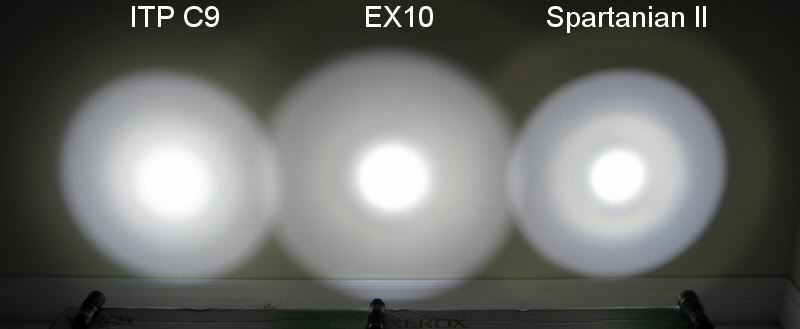
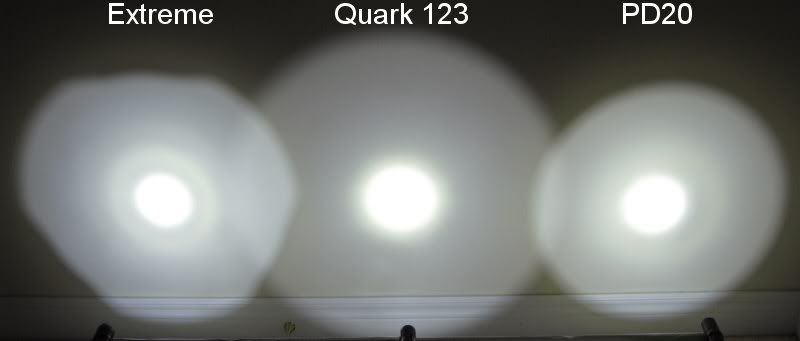
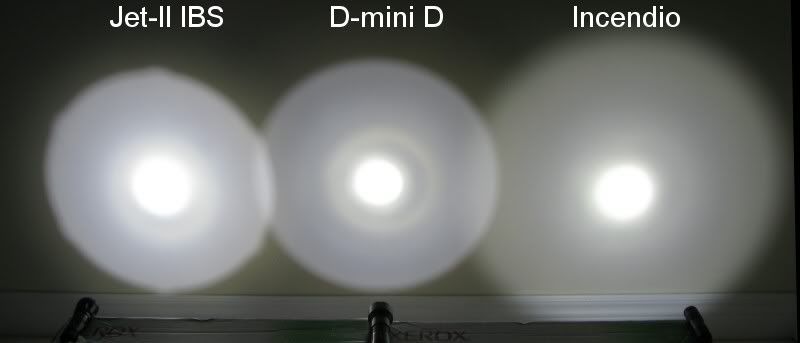
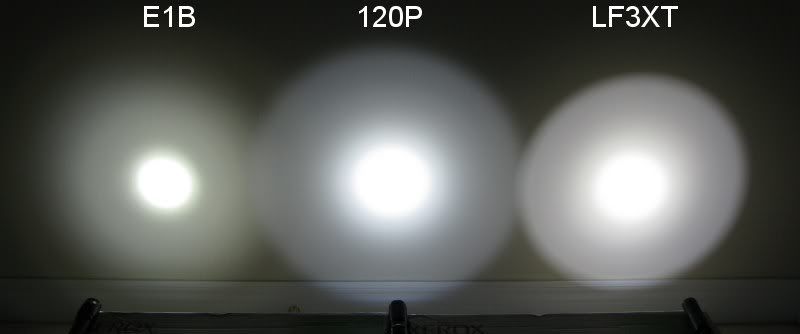
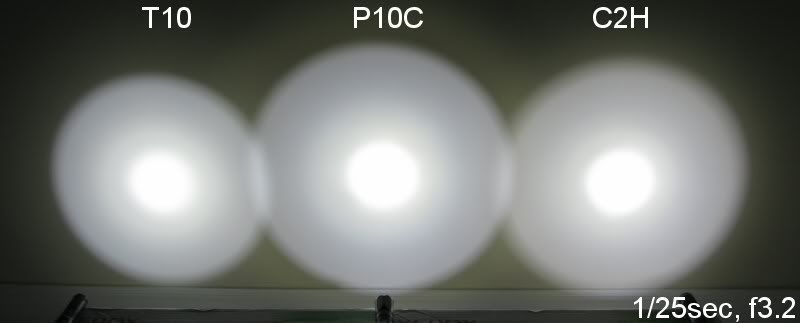
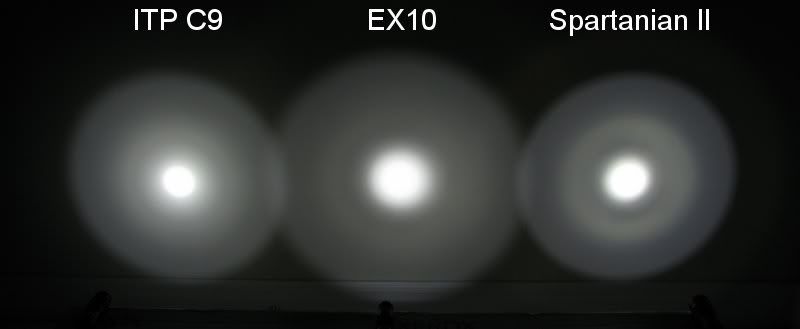
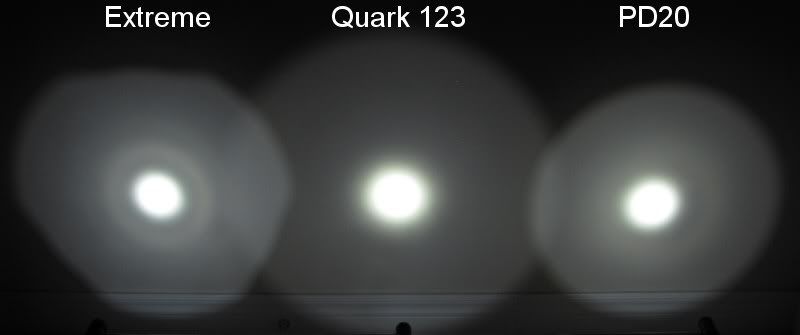
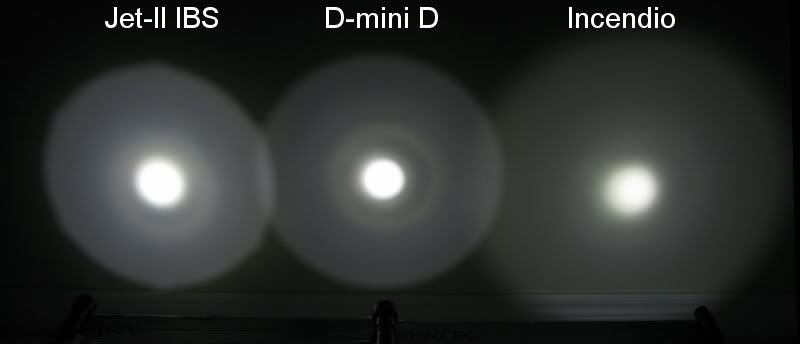
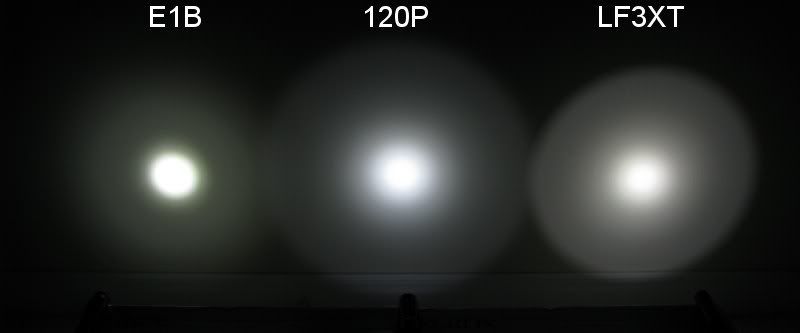
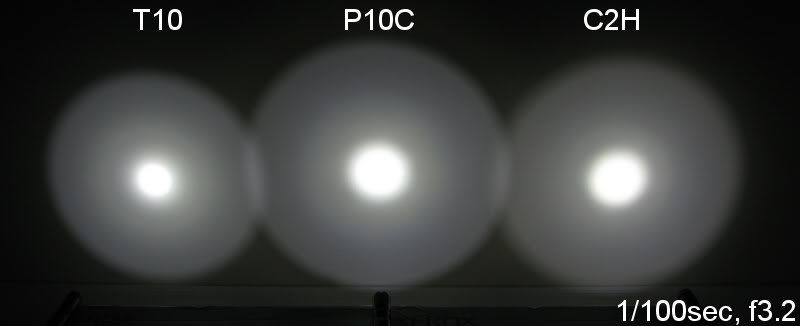
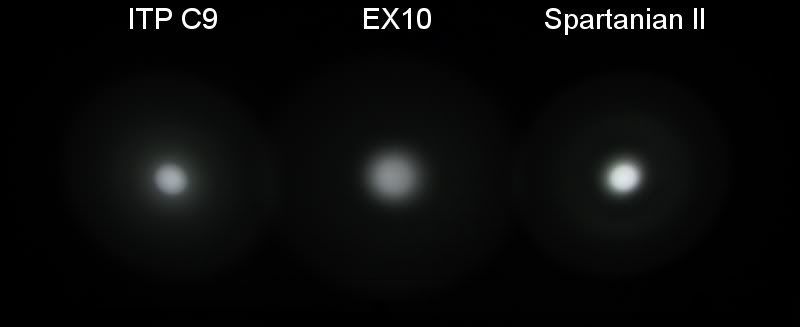
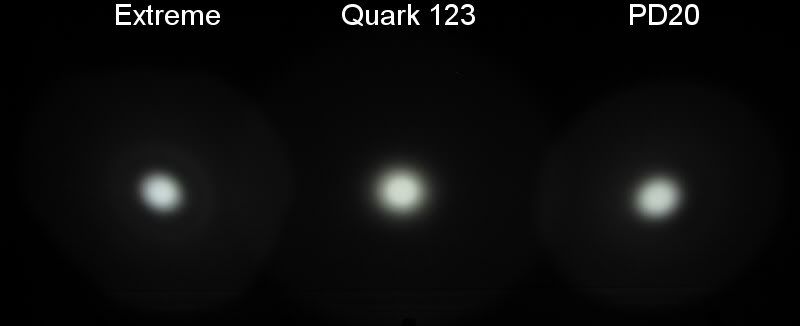
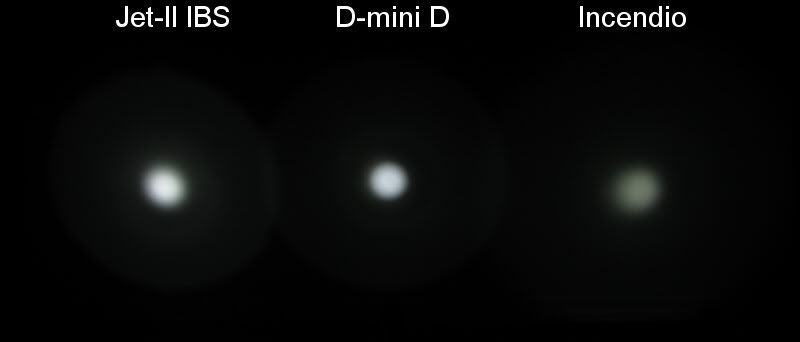
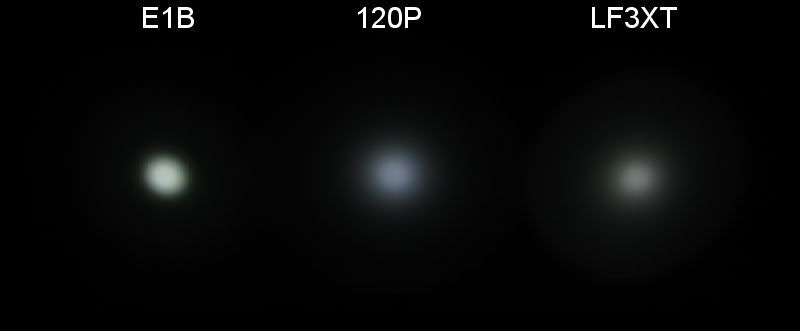
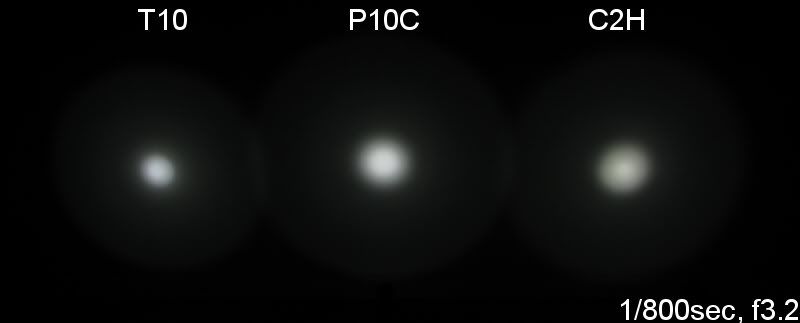
Note: although not shown, the Olight I10 has the same reflector and beam pattern as the Olight T10 and ITP C9 above.
The Jet-II PRO is similar to the Jet-II IBS shown above - see my detailed comparison review for beamshots.
For the GDP version of the NiteCore EX10, see my detailed comparison
NiteCore D10 & EX10 Reviews: RUNTIMES, BEAMSHOTS, COMPARISONS & more!
Beamshot Observations:
Weights (without battery):
Dereelight C2H: 46.6g
Eagletac P10C: 67.0g
Fenix P2D-Q5: 38.8g
Horus FD-1.3: 53.2g
ITP C9: 65.7g
JetBeam Jet-II IBS: 58.5g
JetBeam Jet-II PRO: 55.1g
Lumapower D-mini Digital: 89.2g
Lumapower Incendio: 31.3g
NiteCore Extreme: 65.4g
NiteCore EX10: 41.0g
Novatac 120P: 72.6g
Olight I10: 42.0g
Olight T10: 42.8g
Romisen RC-N3 II: 62.7g
Spartanian II: 68.0g
Surefire E1B: 66.1g
Output/Throw Summary Chart
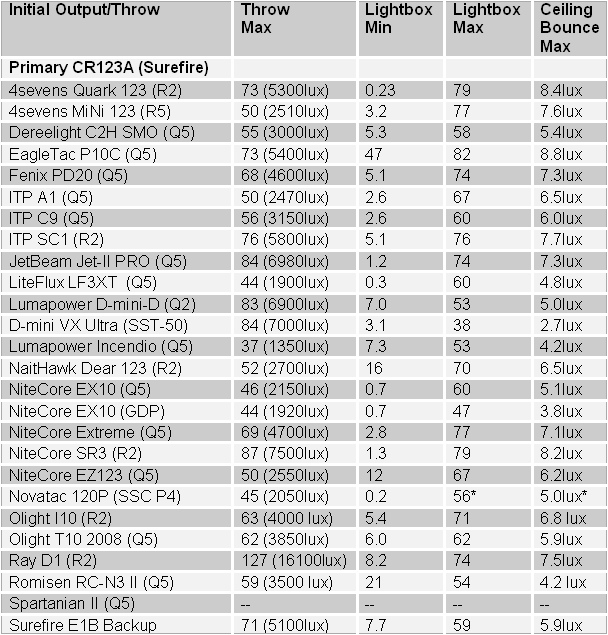
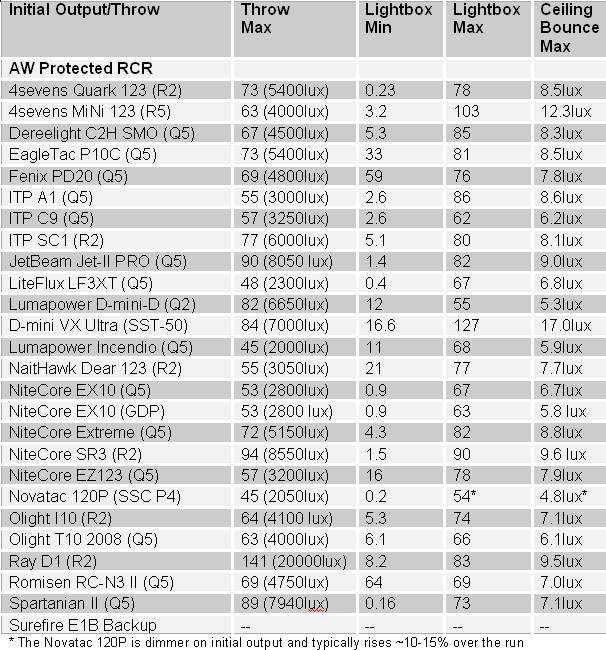
Ramping Comparison:
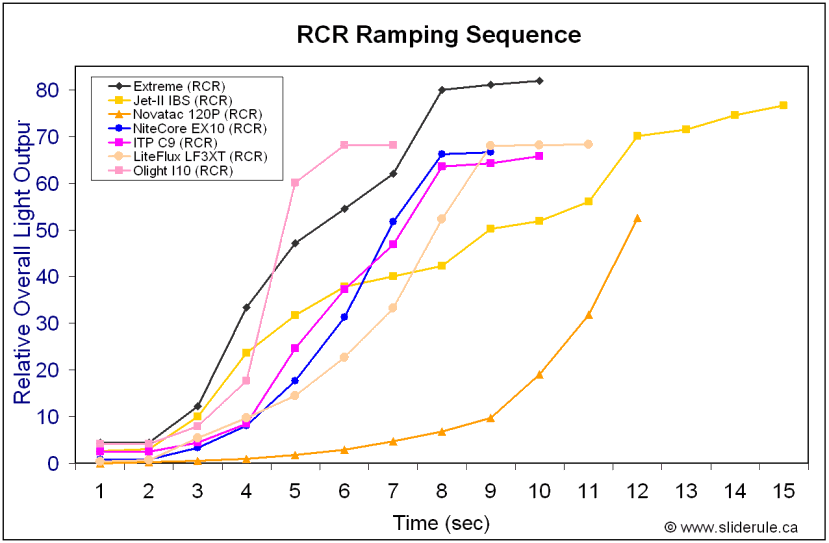
For the lights that have a continuously-variable interface, I have presented their ramping sequences above. As you can see, the EDGETAC and JetBeam lights have relatively visually-linear ramps, although the time it takes to travel the whole range is different. The Novatac is based on defined half-level outputs from max lumens, so you get a visually-curvilear ramping sequence (i.e. the brightness levels are spaced to provide small, even changes in actual brightness, not perceived brightness).
Runtime Comparison
For all comparisons, "Max" mode means the maximum output mode of the light (i.e. Max/Turbo/100%, depending on terminology used for that light). "Min" refers to the absolute minimum output the light is capable of. "Lo/Med/Hi" typically refer to relative output levels on multi-mode lights (in some cases, Min=Lo, Max=Hi). For continuously variable lights, I have tried to match variable output to similar values of the fixed multi-mode lights.
A comment on these graphs: It should go without saying, but there is a lot more to a light's performance than its runtime! I've tried to give some context for each light's overall performance and value in the detailed discussions at the end of the review. The purpose of these graphs is to simply let you quickly compare output/runtime at a glance. But there are caveats here - for example, strong throwers tend to have slightly lower output scores in my lightbox, compared to floodier lights driven to the same levels.
Note also that for consistency, I've listed runtimes in the legends as time to 50%. But as you'll see on the graphs, total runtime of usable light can be quite different (and variable). I think the overall visual impression of the graphs is probably the most useful measure, but it is still just one variable for you to consider. My output scale is also not perfectly linear - see post#2 for a lumen conversion discussion.
On Surefire CR123A primary
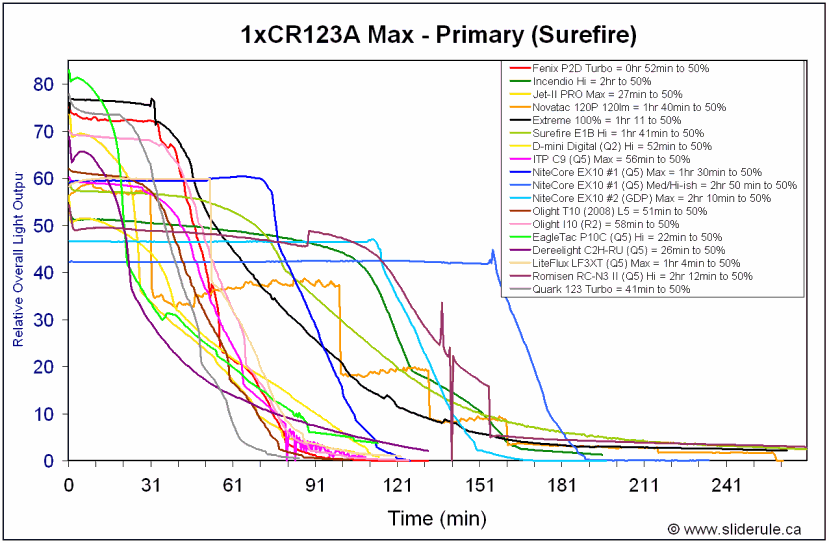
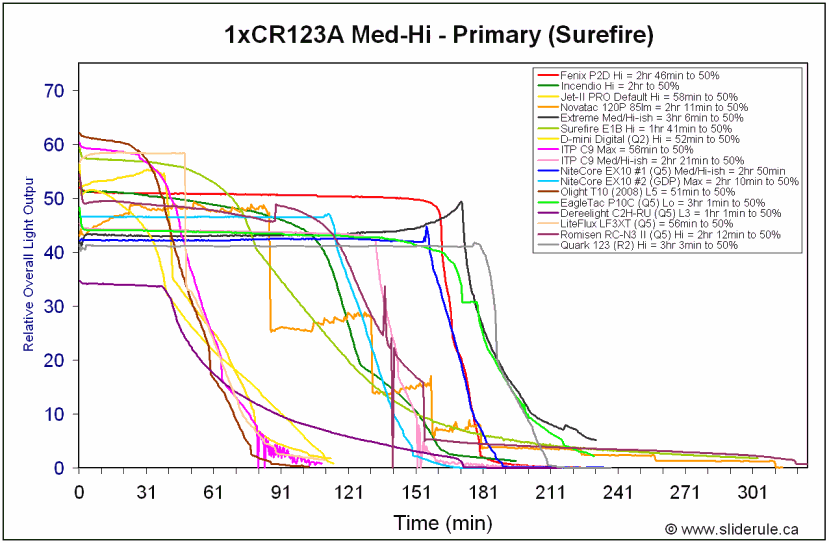
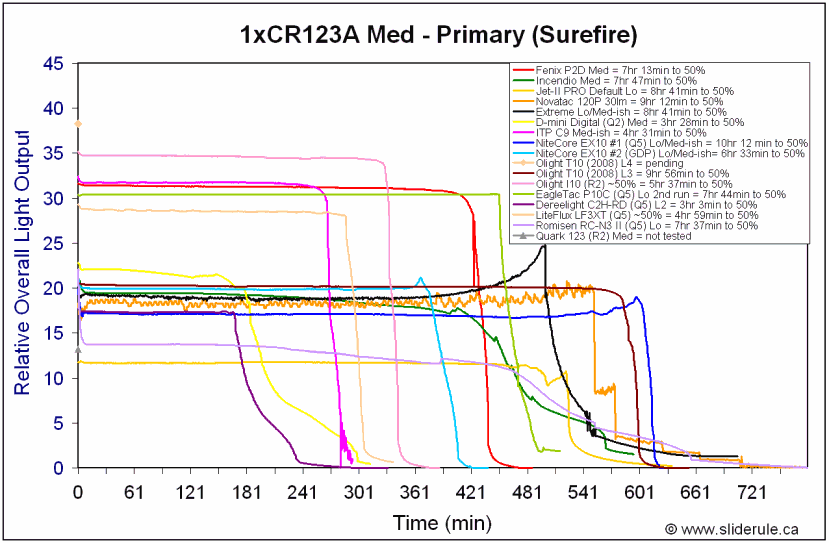
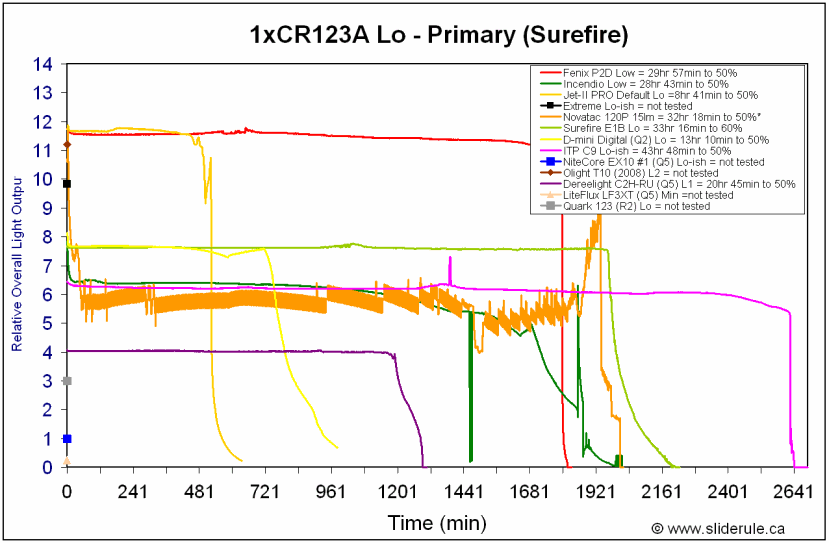
* NOTE: Although the Novatac 120P run was started at 15 lumens (level 16), the light output quickly dropped in half to 7.5 lumens (level 14) for the entire run. Not sure why this happened, but I've left the trace in since it gives you a good comparison to the other low levels.
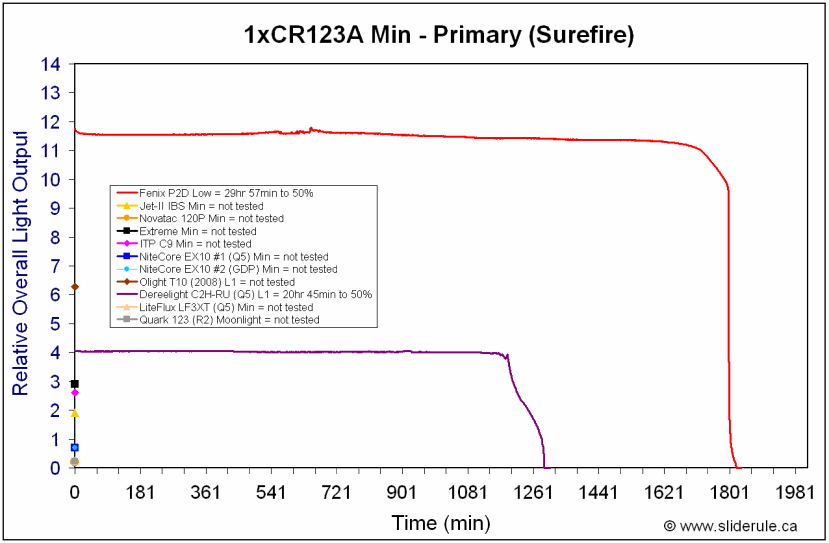
On an AW Protected 14500 (black-label, 3.7V, 750mAh)
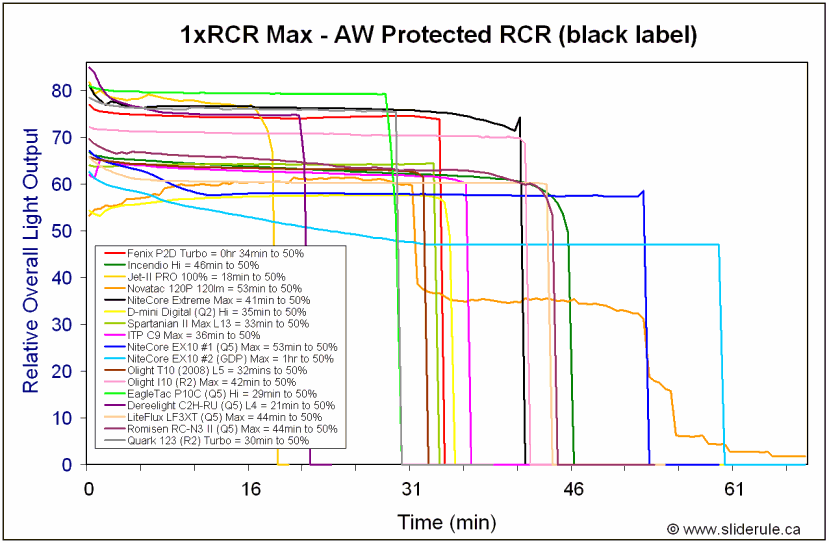
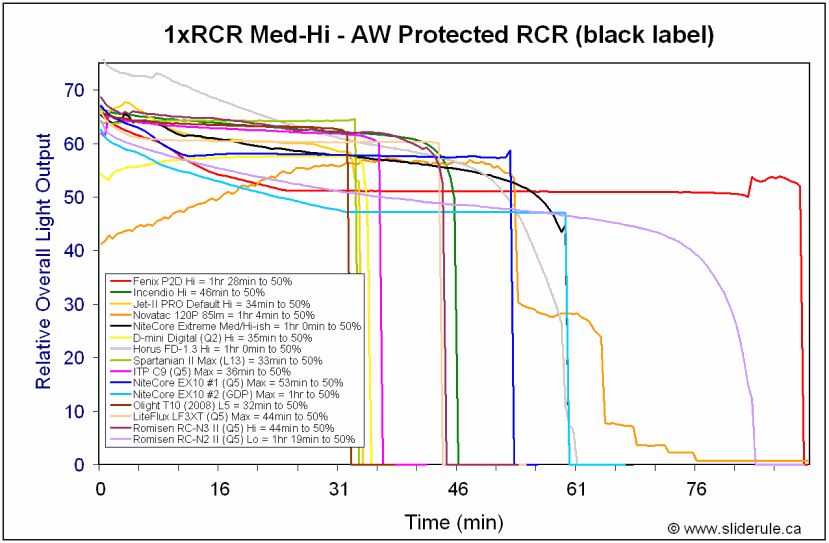
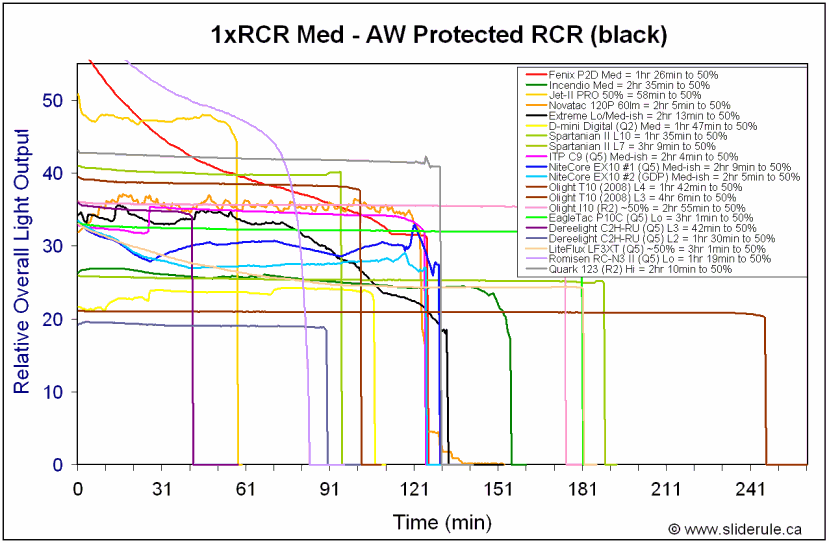
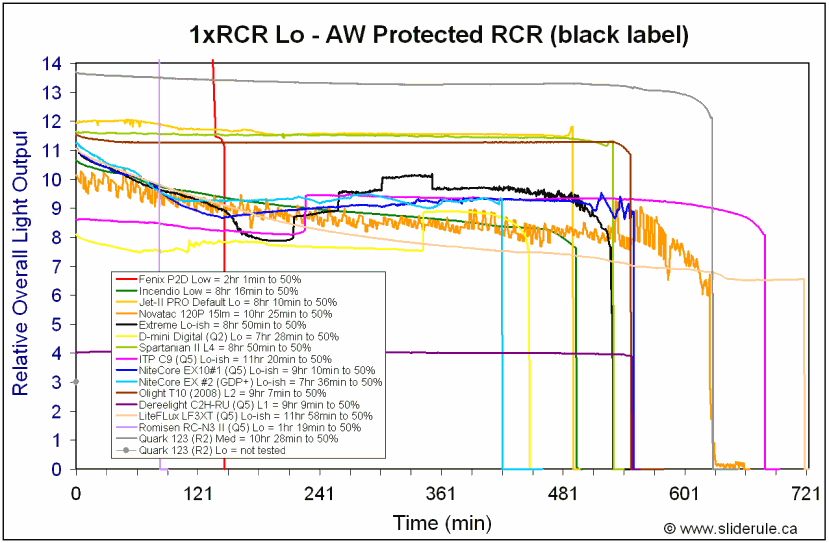
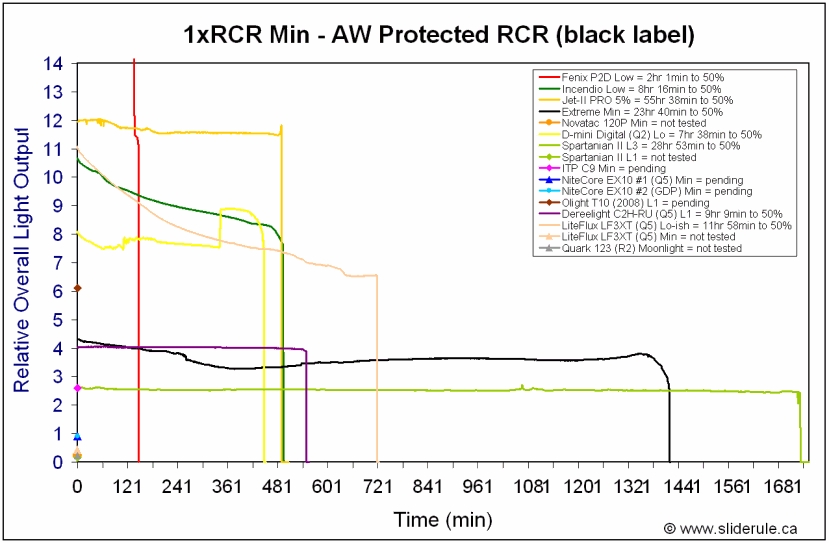
The Jet-II PRO and Jet-II IBS use the same circuit, so I've left only the original Jet-II IBS results above. See my detailed Jet-II PRO comparison review for a discussion of potential runtime differences.
Light Summaries:
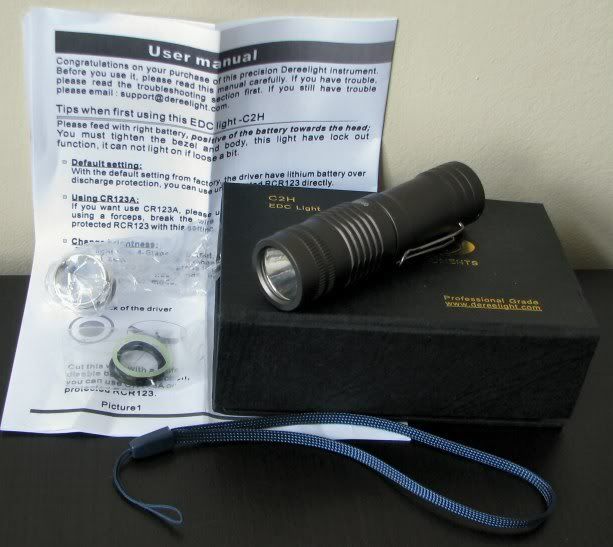
Dereelight C2H (WC Q5, 5A Q3, or R2 available):
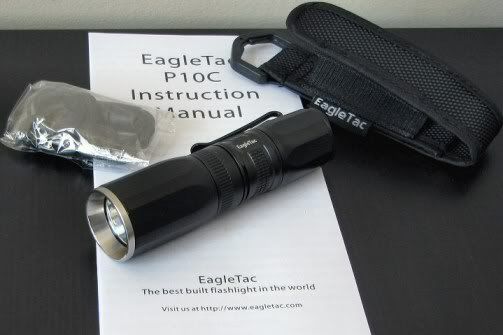
Eagletac P10C (Q5):
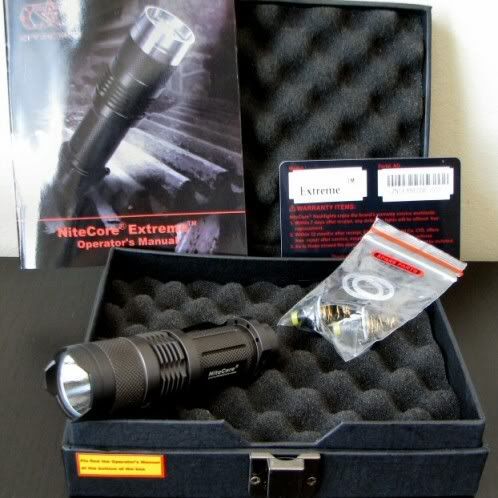
EDGETAC NiteCore Extreme (Q5):
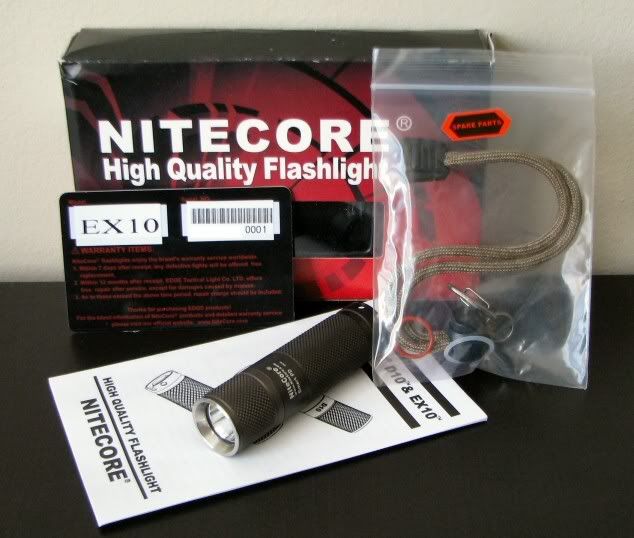
NiteCore EX10 - Cree Q5 and GDP versions
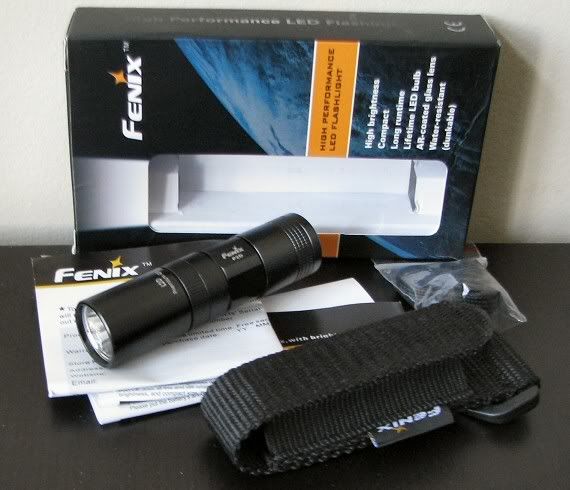
Fenix P2D (Q5):
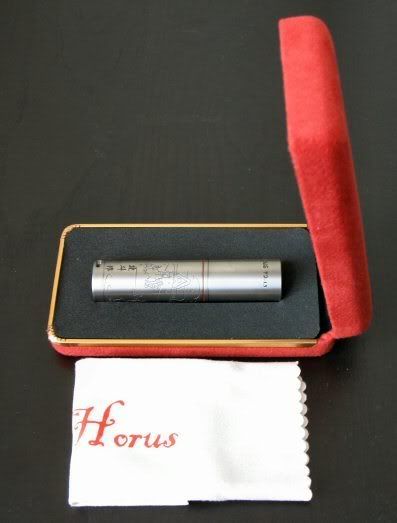
Horus FD-1.3 Titanium (Q5) - RCR-only
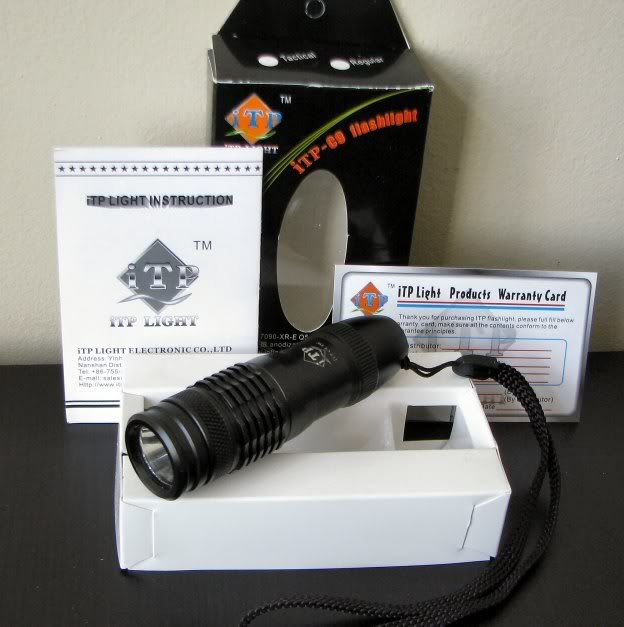
ITP C9
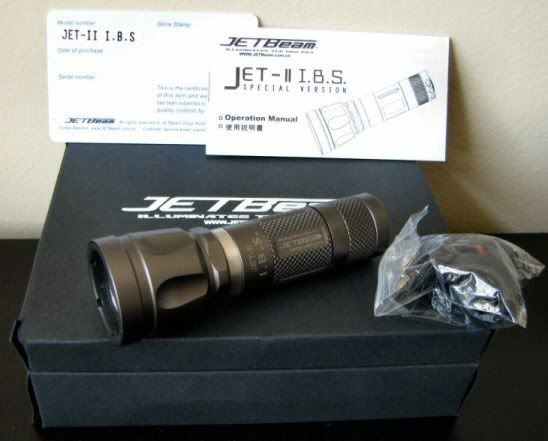
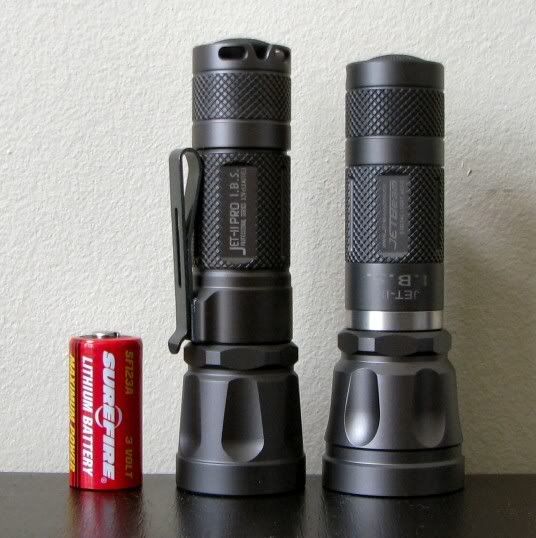
JetBeam Jet-II IBS (Q5):
JetBeam Jet-II PRO (Q5)
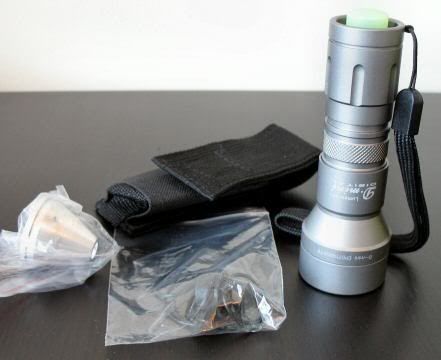
Lumapower D-mini Digital (Q2)
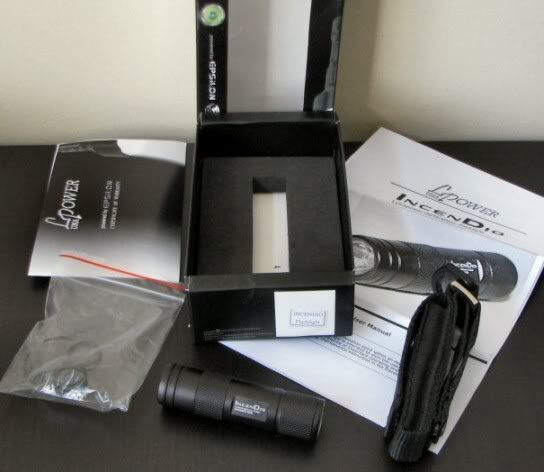
Lumapower Incendio (Q5)
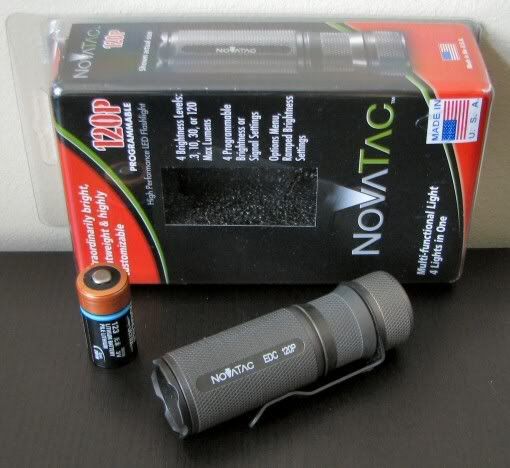
Novatac 120P (SSC)
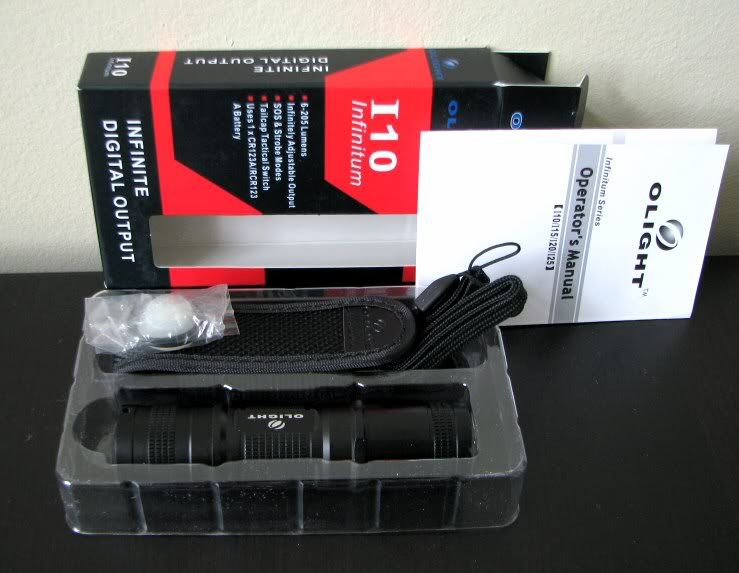
Olight I10 (Cree R2):
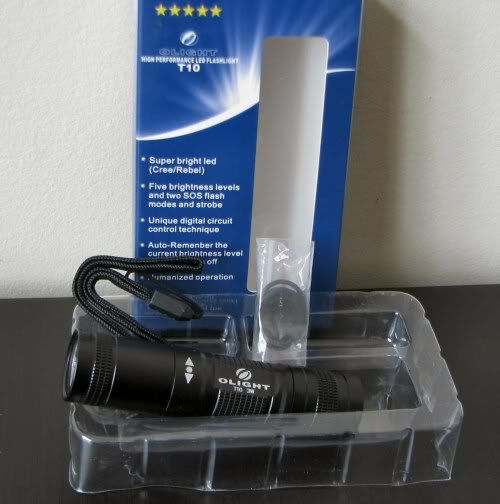
Olight T10 (Q5) - 2008 Model
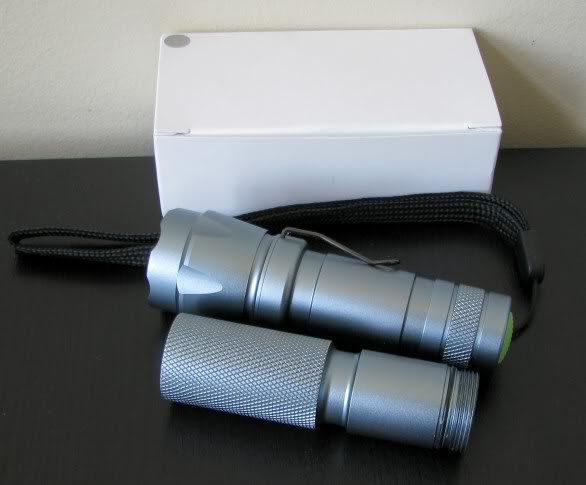
Romisen RC-N3 II (Q5)
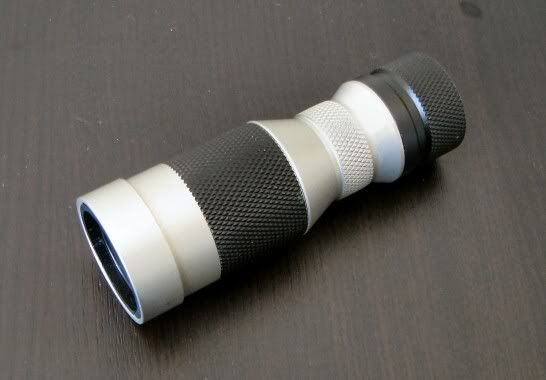
Spartanian II (Pre-production)
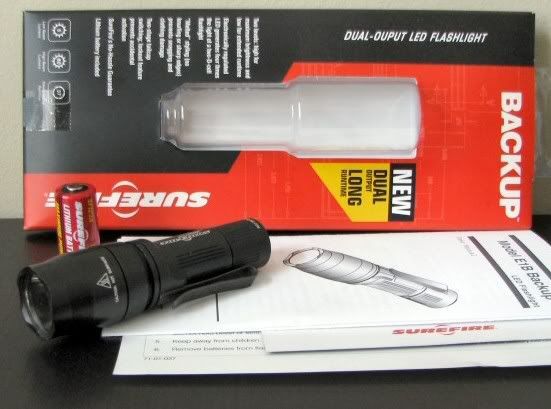
Surefire E1B Backup
A few thoughts:
:sweat: That's it for now.
I will continue to update this thread as new single CR123A/RCR lights come out and find their way into my hands.
REVIEWER'S NOTE: This is my first round-up review of my 1xCR123A/RCR lights, similar in format to my Multi-stage 1xAA - Part IV, 2xAA and Thrower round-ups.
For a discussion of the color rendition properties of different emitters and tint bins, please see my comparison thread: Color Rendition and Tint Comparison: Cree, Rebel, GDP, Nichia
Warning: this post is very pic and text heavy!
UPDATE June 10, 2009: Added Olight Infinitum I10 to the review
UPDATE APRIL 30, 2009: Added Romisen RC-N3 II to the review
UPDATE JANUARY 1, 2009: Added Dereelight C2H to the review
UPDATE OCTOBER 17, 2008: Added EagleTac P10C and Olight T10 to the review
The contenders:
From left to right: EDGETAC NiteCore Extreme, Fenix P2D, Horus FD-1.3 Titanium, JetBeam Jet-II IBS, Lumapower D-mini Digital and Incendio, Novatac 120P, Surefire E1B Backup.


Additional lights: Spartanian II, NiteCore EX10 Cree Q5 and GDP, ITP C9,Olight T10, Eagletac P10C, Dereelight C2H. Not shown are the Romisen RC-N3 II and Olight I10.


For a comparison pic of the Jet-II PRO, scroll down to my detailed discussion section.
Testing Method: All my output numbers are relative for my home-made light box setup, a la Quickbeam's flashlightreviews.com method. You can directly compare all my relative output values from different reviews - i.e. an output value of "10" in one graph is the same as "10" in another. All runtimes are done under a cooling fan, except for the extended run Lo/Min modes which are done without cooling.
Throw values are the square-root of lux measurements taken at 1 meter from the lens, using a light meter.
Beamshots:
All up-close beamshots are at ~0.5 meter from a white wall, to show you the different overall patterns.
On Max/Turbo/100% with AW Protected RCR (black label), except Surefire E1B which is on a Surefire CR123A primary.















Note: although not shown, the Olight I10 has the same reflector and beam pattern as the Olight T10 and ITP C9 above.
The Jet-II PRO is similar to the Jet-II IBS shown above - see my detailed comparison review for beamshots.
For the GDP version of the NiteCore EX10, see my detailed comparison
NiteCore D10 & EX10 Reviews: RUNTIMES, BEAMSHOTS, COMPARISONS & more!
Beamshot Observations:
- Horus does one a great job minimizing Cree rings. The Incendio does a pretty good job too (and can be easily adjusted slightly if isn't already - the head isn't potted).
- The Extreme has a triangular beam profile at close range due to the crenelations on the bezel. These are not noticeable at a distance (and completely missing in the smooth stainless steel bezel version)
- The Novatac has one of the smoothest beam profiles thanks to its SSC emitter and textured reflector.
- The Surefire E1B actually has less spill than the image above suggests, due to its optic (i.e. dedicated throw hotspot at a distance). But at this distance from the wall, it looks like there's a lot of spill (trust me, there isn't). It also has an even warmer tint in real life (bordering on green), but I actually rather like it. As you can see, my E1B's optic is perfectly centered, but there's often some degree of misalignment causing an irregular shaped ring around the corona.
- The D-mini Digital and Jet-II IBS very ringy looking at close range, but that's because they are dedicated throwers. The Extreme and Surefire E1B also have very good throw (scroll down for the output/throw summary).
- The NiteCore EX10 (Cree version) has a fairly typical Cree profile
- The ITP C9 does a pretty good job minimizing Cree rings with its partially textured reflector
- The Spartanian II pre-production reflector is designed for max throw, and so is fairly ringy (note the shipping versions with come with a choice of reflector).
- The Olight T10 and Eagletac P10C both have good throw with minimal rings. The Dereelight C2H comes with both smooth and textured reflectors (textured shown)
Weights (without battery):
Dereelight C2H: 46.6g
Eagletac P10C: 67.0g
Fenix P2D-Q5: 38.8g
Horus FD-1.3: 53.2g
ITP C9: 65.7g
JetBeam Jet-II IBS: 58.5g
JetBeam Jet-II PRO: 55.1g
Lumapower D-mini Digital: 89.2g
Lumapower Incendio: 31.3g
NiteCore Extreme: 65.4g
NiteCore EX10: 41.0g
Novatac 120P: 72.6g
Olight I10: 42.0g
Olight T10: 42.8g
Romisen RC-N3 II: 62.7g
Spartanian II: 68.0g
Surefire E1B: 66.1g
Output/Throw Summary Chart


Ramping Comparison:

For the lights that have a continuously-variable interface, I have presented their ramping sequences above. As you can see, the EDGETAC and JetBeam lights have relatively visually-linear ramps, although the time it takes to travel the whole range is different. The Novatac is based on defined half-level outputs from max lumens, so you get a visually-curvilear ramping sequence (i.e. the brightness levels are spaced to provide small, even changes in actual brightness, not perceived brightness).
Runtime Comparison
For all comparisons, "Max" mode means the maximum output mode of the light (i.e. Max/Turbo/100%, depending on terminology used for that light). "Min" refers to the absolute minimum output the light is capable of. "Lo/Med/Hi" typically refer to relative output levels on multi-mode lights (in some cases, Min=Lo, Max=Hi). For continuously variable lights, I have tried to match variable output to similar values of the fixed multi-mode lights.
A comment on these graphs: It should go without saying, but there is a lot more to a light's performance than its runtime! I've tried to give some context for each light's overall performance and value in the detailed discussions at the end of the review. The purpose of these graphs is to simply let you quickly compare output/runtime at a glance. But there are caveats here - for example, strong throwers tend to have slightly lower output scores in my lightbox, compared to floodier lights driven to the same levels.
Note also that for consistency, I've listed runtimes in the legends as time to 50%. But as you'll see on the graphs, total runtime of usable light can be quite different (and variable). I think the overall visual impression of the graphs is probably the most useful measure, but it is still just one variable for you to consider. My output scale is also not perfectly linear - see post#2 for a lumen conversion discussion.
On Surefire CR123A primary




* NOTE: Although the Novatac 120P run was started at 15 lumens (level 16), the light output quickly dropped in half to 7.5 lumens (level 14) for the entire run. Not sure why this happened, but I've left the trace in since it gives you a good comparison to the other low levels.

On an AW Protected 14500 (black-label, 3.7V, 750mAh)





The Jet-II PRO and Jet-II IBS use the same circuit, so I've left only the original Jet-II IBS results above. See my detailed Jet-II PRO comparison review for a discussion of potential runtime differences.
Light Summaries:

Dereelight C2H (WC Q5, 5A Q3, or R2 available):
- The C2H is Dereelight's attempt to create a small EDC light that is easily configurable and upgradeable - and maximally driven on a single CR123A/RCR
- The C2H has four output levels, typically refered to as Lo-Med-Hi-Burst (L1 to L4 on my runtime charts). The C2H is available in two versions, Ramp Up (RU) and Ramp Down (RD), which differ only in their output order sequence. Modes are accessed by repeatedly soft-pressing on the clicky (full click to lock-on). Light has memory feature to retain last setting used.
- Lower outputs on the C2H are PWM-based, but at such a high frequency as to be undetectable by eye or with my setup.
- Output is extremely high on Burst mode (L4), and ithe C2H s one of the brightest 1xRCR lights in my collection.
- Lights comes with a low-voltage shut-off feature enabled by default, allowing you to safely run unprotected RCRs. This feature can be diasabled by cutting a circuit trace on the contact disc in the head, thus allowing you to run primary CR123A batteries in the light. See my C2H review for more info.
- Light comes with two reflectors - OP for smooth beam, SMO for maximum throw. Throw is decent this size light.
- Light uses a forward clicky switch with good feel. Light design allows tailstanding, but switch can still be easily activated.
- Light has anodized head threads, allowing for lock-out.
- Comes with a bezel-pointing clip that is not removeable.
- Build quality is very high, and seems to be a sturdy package in a small size.
- Overall output/runtime efficiency is considerably lower than other lights of its class, especially on Med-Hi settings. Hopefully Dereelight will rectify this with an improved circuit soon.
- Light retails for ~$65. Various pill/emitter combinations are available, and can be purchased separately.

Eagletac P10C (Q5):
- Eagletac lights use a basic 2-stage output system, controlled by a twist of the head (similar to the Fenix LxT design).
- Like Fenix, Eagletac appears to use a current-controlled low mode (i.e. no PWM). This produces very good runtime for its output level. Unfortunately the Lo mode is still extremely bright on the P10C - I would consider the two states to be Regular and Turbo, instead of Lo and Hi.
- Output is extremely high on the Turbo mode, one of the brightest 1xCR123A lights in my collection.
- Reflector design on P10C is excellent, with a deep textured reflector that produces a lot of throw with surprisingly little evidence of Cree rings.
- Light uses a forward clicky switch, that is recessed enough in the tailcap to still allow tailstanding.
- Light has anodized tailcap threads, allowing for lock-out.
- Comes with a bidirectional clip that allows attachment in both bezel up and bezel down modes. Note that placement of the clip is toward the rear of the light, interfering somewhat with your ability to unscrew the tailcap easily. Also reduces stability when the light is clipped in a bezel-up orientation.
- Overall build quality is very high, with a lot of signs of care and consideration in the design.
- Light retails for ~$55.

EDGETAC NiteCore Extreme (Q5):
- EDGETAC's continuously variable lights use PWM, but at a high enough frequency that I cannot detect it with my setup or see it by eye (EDGETAC claims >1 kHz).
- Beam profile is fairly typical for a Cree light. Even with its textured reflector, it has very good throw for its size. Note that the crenelations on the bezel (optional, also comes with stainless steel bezel head) introduces a slight "triangulation" of the spillbeam at close range.
- Like the popular NiteCore Defender Infinity (NDI), the Extreme allows you to set your low mode (i.e. user defined mode) through a continuously variable brightness mechanism that is visually linear across its ramp.
- The light is controlled by a forward clicky switch (i.e. momentary on, followed by a click to lock-on). Extra clicky switches are thoughtfully included in the package.
- User interface is quite elegant and easy to use, IMO. Simple and straight-forward, it does require two hands to switch modes (done through a bezel twist, not a click - see my review for more info). Note that strobe is neatly tucked away so you don't need to see it if you don't want to.
- Excellent output - one of my brightest single CR123A/RCR lights. Output is slightly higher on RCR than primary CR123A.
- Output/runtime characteristics are very good at all settings tested, with well regulated output on both battery types in all output modes.
- Build quality is high, with flawless hard anodizing (dark brownish black) and clear, bright lettering on my sample - very attractive, IMO.
- Light lacks a tailcap lockout, since body/tail are one piece (note that the tailcap retaining ring is external, like on some Surefire models). Comes with a bezel-pointing removable clip (secured with two torx screws, allen key included).
- Body tube is too narrow to take my older blue-label AW protected RCRs, but all my newer black-label ones fit (some can be a bit snug).
- Special bonus - the Extreme head is compatible with all Surefire E-series lights, so you can swap your Surefire heads for this light. :thumbsup:
- For a lot more info, please see my Extreme review here.
- Light retails new for ~$88.

NiteCore EX10 - Cree Q5 and GDP versions
- Please see my detailed reviews (links above) for more info on these very popular lights. A few key points:
- Lights are continuously-variable.
- Lights use PWM to produce low modes, at an undetectable frequency. :thumbsup:
- Lights use an innovated "piston-drive" design - first time I've seen this is a mass-market light.
- Build quality is quite high, with more aggressive knurling that commonly seem on Chinese-made lights.
- Main differences between Cree Q5 and GDP versions is in the beam profile and pattern. Please see my comparison of the two here: NiteCore Golden Dragon Plus D10 & EX10 Reviews: BEAMSHOTS, RUNTIMES, etc.
- Retail price is ~$55 for both models (and is quite a bargain, in my view)

Fenix P2D (Q5):
- The Fenix P2D/LxD head has come with various emitters over the years (from Cree P4 through Q5, and Rebel R100). The various versions are compared in my original Fenix Rebel vs Cree: OUTPUT, RUNTIMES, BEAMSHOTS thread. The Cree Q5 is the brightest of the group, and the one reviewed here (with textured OP reflector).
- In my sample, the Cree Q5 has a traditional Cree beam profile with visible dark rings, despite the OP reflector. Throw is still pretty good for a textured reflector.
- Fenix remains the output/runtime king on primary batteries - nothing else beats the efficiency of the Fenix's current-controlled low modes. :thumbsup: The main problem is that they can't go as low as the PWM lights reviewed here.
- On RCR, you loose all the low modes initially, as light runs in direct drive from max output until it hits the low mode output level. At that point, it then switches into regulation - but only briefly, as the battery is typically almost exhausted by then.
- Light comes with a reverse clicky and allows tailstanding. A protruding forward clicky is available, but this is better suited to simpler two-mode LxT series lights.
- User interface is excellent on the Fenix lights, IMO. Twist the bezel to switch between Min and Turbo output modes. In Min mode, soft-press the clicky to access Med-Hi-Strobe. In Turbo, soft-press to access SOS.
- Build quality is very good. Fit and finish is very nice, although some find the Fenix bodies a bit slippery. Fenix pouches are also well made, and useful for carrying a number of lights.
- I understand the newest batch of heads have a revised circuit with reverse battery polarity protection (haven't confirmed that personally yet).
- See my
- See my Fenix L2D Q5 vs R100, R80, Q2, P4 Comparison Review: RUNTIMES+ for an analysis of the premium Cree Q5 and Rebel R100 heads on L2D form.
- Currently, the "premium" Cree Q5 version of the P2D retails new ~$55.

Horus FD-1.3 Titanium (Q5) - RCR-only
- NOTE: Horus is planning on replacing this current RCR-only multi-mode light with a continuously-variable model. I'll update this thread once they send me a sample for testing.
- The light uses PWM for its low modes. For Medium mode, I measured frequency at a decent 159Hz. For Low mode, freq was 91 Hz. Strobe mode is 9 Hz.
- As you can see, the Horus FD-1.3 has a very similar max output and beam profile to the P2D, but with no sign of the dreaded Cree rings in my sample. :thumbsup:
- Output is semi-regulated, but Medium and Low are set to good levels relative to Max. Nice to see such a low Lo level on a Li-ion light.
- The light features a low voltage cut-off of 3.2V, so it is quite safe to run unprotected batteries in this light. I confirmed the resting voltage of an unprotected ultrafire RCR was ~3.2V immediately after shutdown occurred.
- Clicky is a forward clicky, but with a longer traverse than most switches (i.e. requiring you to press further to activate). Horus advises that use of this switch was necessitated by their desire to retain waterproofness (claim waterproof to 40m!). The light can tailstand.
- User interface is straight-forward: you can soft-press to momentary turn on the light, and repeatedly soft-press to cycle through the modes. Click to lock the light on. The light automatically advances to next mode in the sequence once you turn off/on. To memorize the current mode, press and hold the clicky for 5 secs before turning off.
- Build quality is quite high. Titanium finish is very smooth, and laser engraving is top notch (Horus can engrave your own desired logo/scene, as well as was creating a knurling finish). Screw threads came dry and needed some lube.
- Light has a plastic disc in the head for reverse battery protection (i.e. uses a mechanical barrier instead of a circuit). The disc on my sample was a little too thick to allow some batteries to make contact with the head, so Horus revised this to a thinner one on later samples. You can also remove it all together if you want, although this will also remove the reverse polarity protection.
- Semi-regulated runtimes are good for the output levels. I'm looking forward to seeing how their new multi-mode continuously-variable circuit performs.
- Light comes in a nice jewelry-style presentation case with microfibre cleaning cloth.
- Light retails new for ~$130 (remember, it is Titanium
).

ITP C9
- Please see my detailed review (link above) for more info on this new entry into the flashlight world. A few key points:
- Light is continuously-variable, with an innovative simple turn of the head to activate (no switching required)
- Lights use PWM to produce low modes, at an undetectable frequency.
- Build quality is quite good, with a two-stage textured/smooth reflector similar to the early Olights.
- Head is interchangeable with 1AA and 2AA body tubes, sold separately (ITP C7 and C8 versions)
- Pre-order price was ~$50, which is extremely competitive for the feature set.


JetBeam Jet-II IBS (Q5):
JetBeam Jet-II PRO (Q5)
- JetBeam has replaced this initial Jet-II IBS with the new Jet-II PRO - comparison pic above. Both lights use the same IBS circuit, but there are some build differences, discussed below
- All JetBeam lights use PWM, to my knowledge. On these lights, the frequency is high enough that I can't detect it by eye or instrument, even at the lowest output settings.
- The Jet-II series is designed for throw, and these are the best throwing single CR123A/RCR in my collection at the moment. The original Jet-II IBS has a wider reflector than the PRO (~3mm wider), and throws slightly farther (~10% more throw on my samples).
- Spillbeams are narrower but brighter than most lights, thanks to the deep reflector (OP in my case, but smooth is also available). The PRO has a slightly narrower spillbeam than the original IBS version
- On the Jet-II IBS (but not PRO) you can selectively unscrew the head to de-focus the emitter (i.e. make it more "floody"). You can lock the desired focus in place by adjusting the focus ring. Of course, this doesn't really turn it into a flood light, but the execution on the Jet-II IBS is better than other many other focusable lights I've seen. Can also be very useful in helping deal with the infamous Cree rings. For pics of this effect, see my Jet-II IBS review.
- Maximum output is the highest of any of my single CR123A/RCR lights. However, judging from the runtimes on RCR, I'd estimate >3C discharge rate at 100%!
oo: That's not too good for Li-ions, and may result in unexpectedly low runtimes and shortened long-term battery storage capacity. I don't recommend running the light for extended periods higher than the Default Hi setting (see my Jet-II PRO comparison review for a discussion).
- Output on CR123A is a bit less than RCR, and output/runtime efficiency on both RCR and CR123A is very good at lower output modes (although only ok at higher modes). No signs of the Med-Hi efficiency problems of the IBS circuit on NiMH/alkaline, or the earlier Li-ion Med-Hi efficiency issues in the Jet-I PRO (non-IBS version).
- My Jet-II PRO had slightly lower output on runtime than my Jet-II IBS (results shown above), but this likely just reflects variation in emitter luminous flux and Vf bin.
- Low output is nice and low with this circuit - among the lowest I've seen for a CR123A/RCR light. :thumbsup:
- Lights use a reverse clicky and cannot tailstand. Clicky feel is better than the tailstanding 1AA JetBeam lights (i.e. less "stiff").
- User Interface is excellent, with multiple modes controlled through the clicky switch. The IBS circuit allows you to set three defined output states (A, B, C) through a continuously-variable brightness mechanism. Pre-sets are available at 5%, "default low", 50%, "default hi", and 100%. A number of strobe and SOS modes are also available, but you don't need to see them if you don't want to. See my detailed Jet-II IBS review for more info.
- Build quality is generally excellent. Type III (hard) anodizing is a dark grey colour, with perfect finish on my sample.s However, lettering is not always perfectly clear (can be faded in places). Note the tailcap switch retaining ring is plastic on all JetBeam lights, which some object to for potential long-term stability reasons.
- Tailcap threads are not anodized on the original Jet-II IBS, but they are on the new Jet-II PRO. This allows a tailcap lock-out only on the PRO.
- The PRO also has a good bi-directional clip, similar to the Surefire E1B shown here.
- The larger Jet-III PRO IBS uses a similar size head and circuit as the original Jet-II IBS, so has similar beam characteristics with much greater runtime (18650-only model). Much safer for running at 100%, IMO.
- No doubt about it, the Jet-II IBS and PRO are the best throwing pocket throwers I've come across (but I don't recommend using the light for prolonged periods at max output).
- Both IBS and PRO versions retail for ~$65.

Lumapower D-mini Digital (Q2)
- Note that my sample is only a Q2 - Q5 versions of this light are also available
- I'm not sure how the D-mini Digital regulates its low modes, but if it uses PWM the frequency is too high for me to detect by eye or by instrument. Likely current-controlled like the Incendio (below).
- Beam pattern is unchanged from the original D-mini, with a tight focused hotspot and a moderately-narrow dim spillbeam. Smooth reflector is used for maximum throw, but an OP textured one is also available.
- The new circuitry results in a considerable increase in output/throw on primaries on Hi, with similar runtime, compared to the original P4 D-mini. Initial output is now similar between CR123A and RCR.
- Output/runtime efficiency of the Med/Low modes is certainly far greater than the resistored low of the original D-mini, and quite respectable overall.
- The D-mini Digital comes on in the following initial sequence: Hi - Med - Lo, repeat (cycle accessed by soft-pressing the forward clicky until the desired mode is found). Click for lock-on.
- The light lacks a memory mode, and will revert to the start of the cycle if you leave it off for more than ~5 secs.
- The protruding forward clicky switch works well and is easy to access with good tactile feel.
- Build quality is generally comparable to the original D-mini, which is quite high.
- The digital D-mini comes in a Hard Anodized natural finish (type III), which is smooth overall - although there is some mottling of the anodizing on the bezel of my unit.
- The lettering, while clear, is more difficult to read on the new digital D-mini - although this may be due in part to the lack of contrast against the natural finish.
- Light doesn't tailstand due to the protruding forward clicky switch - but apparently a #10 o-ring between the tailcap switch cover and the cap can solve this.
- Screw cap threads are partially anodized in the tailcap, so lock-out is possible.
- The original "pocket rocket", this revised multi-level version was most welcome. Remains one of the best dedicated single CR123A/RCR throwers out there.
- Q2 version retails for ~$60, Q5 version retails for ~$75.

Lumapower Incendio (Q5)
- Note: this review is for the 1st generation Incendio. A revised version is now available - see my detailed review of a list of the updates
- Like the Fenix, the Incendio is current-controlled for its low modes, (so no PWM flicker). Typically, I've found that current-controlled lights are more output/runtime efficient than PWM-lights at Med-Lo settings, but can't go to as low output levels.
- Features a wider spillbeam than most lights, due to its shallow reflector. No evidence of Cree rings on my sample (note that the head of the unit can be unscrewed to defocus the beam further, allowing you to customize somewhat). Very attractive beam profile for general use, IMO.
- Relative to its output, the Incendio has very good runtime efficiency in all modes on both primary CR123A and RCR (as good or better than the D-mini Digital). Output levels seem roughly similar to the D-mini Digital (although mine is only a Q2).
- The Incendio has lower output than the Fenix P2D-Q5 in all modes, but with similar or better runtime. In some modes, the Incendio seems to match Fenix output/runtime efficiency.
- Light comes with a forward-clicky that allows tailstanding when in the "on" position. Some find the recessed clicky a little hard to activate, but I don't have any problems.
- Light output sequence is Hi-Med-Lo (no SOS or strobe modes). You can switch between modes with a soft-press, and the light has a memory feature that retains the last setting used if left on for more than 2 secs. Unfortunately, you need to re-set the memory every time you turn on the light on - if you just flash on/off quickly, the light will advance to the next mode the next time you turn it on. User interface is an improvement from previous Lumapower models (e.g. D-mini Digital) that lacked any form of memory, but still not perfect.
- Build quality is quite good, with consistent anodizing and extremely crisp & clear lettering (some of the sharpest I've seen!). Unfortunately, the black anodizing is only "enhanced" type-II (Lumapower calls it "II+").
- Comes with a bezel-pointing clip. Emitter module easily accessible, but the clicky switch cannot be replaced by the end user, unfortunately.
- Body tube too narrow to take older blue-label AW protected RCRs, but newer ones fit fine.
- The smallest multi-level single CR123A/RCR light in my collection, along with the NiteCore EX10.
- Light retails new for ~$55

Novatac 120P (SSC)
- I haven't done a stand-alone review of the 120P, but you'll find plenty of info on this light if you search around here.
- Light uses PWM for its low modes, but frequency is high enough that I can't detect it by eye or instrument.
- The light features a gorgeous beam pattern, thanks to its SSC emitter and well-designed textured reflector (wide and deep). A tight hotspot blends smoothly into an even corona that spreads out to a dim spill, with no rings or irregularities. My only (small) issue is that I personally like a slightly brighter spill, but there's no arguing with the quality of the beam.
- Maximum output of Novatacs are limited to 85 or 120 lumens, depending on the model. Unlike most lights that simply run at a given current draw (and vary in output depending on the voltage characteristics of the specific emitter), Novatac tunes its lights to a common set of outputs (calibrated lumens). This also means that you should expect some variation in runtime from one sample to the next.
- The Novatac "E" (EDC) and "T" (Tactical) versions come with 3 preset output levels that are deemed most suitable for those purposes (the "T" version also has a protruding clicky and momentary on feature). The "P" models are fully programmable and have 4 set-able preset levels, where you can assign any of the possible outputs to each set state.
- The "P" models have 21 or 22 set-able output levels, and 3 signal (SOS/strobe levels). The 120P model has the full 22 levels, the 85P model is missing level 22 (i.e. 120 lumens). Simply put, the difference is based on runtime - unless the light can produce 120 lumens for at least 30 mins on a primary CR123A, it seems that Novatac disables the 120 lumen mode and sells as an 85 lumen max model.
- User interface of the "P" models is more complicated than most lights, and uses a series of repeated clicks and presses to access different features and modes. It is actually quite versatile, and doesn't take long to learn.
- The light uses a microprocessor-controller unit (MCU), so lacks a standard clicky switch. Tactile feel of the button press is quite different from a standard clicky - basically, the difference between a modern electronic device versus an old mechanical one (e.g. like the on/off button on your flat-screen LCD versus the old toggle switch of a big CRT-tube monitor). Switch feel is very good once you get used to it.
- Output/runtime is very good - excellent at the lower levels. However, maximum output is a bit less than many of the newer Cree-based lights shown here.
- Novatacs have an interesting runtime pattern whereby the light drops in half-levels as the battery begins to drain. This gives you continuous regulated performance, just in half-steps from initial output.
- The regulated performance is somewhat "spiky" - the light actually fluctuates rapidly within a narrow range at each output level, as you can see in the graphs.
- The "E" and "P" versions can tailstand, but that is not an absolute guarantee on Novatac's part.
- Build quality is extremely high - the light feels like a mini tank! Heavier and thicker than most single CR123A/RCR lights, build to last.
- Comes with a removable bezel-pointing clip (note: you need to temporarily remove the o-ring to install it).
- There's a lot more to say about this light - but I don't have enough space here! It's a quality item (for further discussion of the relative output levels in my lightbox, scroll down to post #2)
- Light retails for ~$100-160, depending on the model and output level. But if you shop around, you can sometimes find a good deal.

Olight I10 (Cree R2):
- The Olight I-series lights are basically a merger of the older Olight T-series build with the ITP circuit and UI - both revised and tweaked in a new format with the latest R2 Cree emitters. :thumbsup:
- Build is similar to the T10 described below, with the addition of a protruding forward clicky and anti-roll ring.
- Circuit is similar to the ITP C9 described above, with a shortened ramp time and revised UI to support strobe/SOS with a tactical forward clicky.
- Please see the Olight Infinitum Round-up review for a greater discussion of the updates to this line.
- Light retails new for ~$55.

Olight T10 (Q5) - 2008 Model
- Like Fenix, Olight uses a current-controlled circuit for its various output modes. Unlike Fenix, Olight has found a way to maintain regulated output levels on both CR123A and RCR (Fenix is direct drive on RCR).
Note that this applies to the 2008 Olight models - the original 2007 versions had a virtually identical circuit to Fenix.
- Output/runtimes were generally excellent across the range of Olight settings. While the lowest setting is not as low as the PWM-based competition, it is lower than the Fenix P2D.
- Spillbeam width is narrower on the Olight compared to most of the other Crees, but overall output and max throw are similar to the Fenix P2D.
- Light uses a two-stage reflector - textured at the base near the emitter (to smooth out Cree rings), smooth near the top (to improve throw). The same reflector appears to be used in the ITP C9.
- Build quality is very high. Light has a very substantial feel, a bit bulkier than the Fenix model, but otherwise with very similar overall build features.
- Press the reverse clicky tailswitch to activate the light. Light intensity is controlled by a loosen-tighten switch of the head (see below for a UI description). Soft-pressing the tailswitch will move you into a tactical strobe mode followed by a SOS mode (good for those who don't like these modes - they are out of the way, so you don't need to see them).
- There are 5 distinct output modes controlled by the head switch. Switching sequence is from Max to Min output. Light has a memory mode retaining the last level used.
- Ability to retain output levels on RCR is a real plus for these 2008 models. :thumbsup: It is disappointing that Fenix hasn't managed to introduce this for their new PD20 series.
- Anodized tailcap threads allow for lock-out, and the light can tailstand.
- Build quality is very good - at least as good Fenix in my experience. Previously, I considered the 2007 Olights to be roughly equivalent to the corresponding Fenix models (except for a different UI), but the 2008 Olights definitely have an advantage with the full RCR support on this new circuit.
- Light retails new for ~$50

Romisen RC-N3 II (Q5)
- The Romisen RC-N3 II is a two-stage version of the popular budget RC-N3 budget light (1xCR123A with 2xAA body tube). AFAIK, this two-stage Q5 light is only available from shiningbeam.com.
- The RC-N3 II is the first true "budget" light I've included in this review, so overall build and performance is not expected to perform at quite the same level as the more expensive "brand name" premium lights.
- Max output on primary CR123A is toward the low end of 1xCR123A lights. Lo mode is reasonably good for a two-stage light. Output/runtime efficiency is fairly good on both Hi and Lo on primary CR123A
- On RCR, I'm afraid you loose the regulated lo mode. Instead, you get regulated output on the Hi mode and unregulated direct-drive on Lo. Overall efficiency of these regulated Hi and unregulated Lo modes is pretty good.
- Beam pattern is quite good - reflector is textured, producing a pleasant beam. Throw is about typical for a 1xCR123A light.
- Light includes tailcap annodizing, so tailcap lock-out is possible. But the anodizing doesn't seem to be perfect on my sample - I found that I could still activate intermittently even when slightly unscrewed.
- Slightly protruding forward-clicky tailcap, comes with a GITD button cover. Can't tailstand, but momentary-on feature is likely to be popular.
- Interface is straight-forward - click once for Hi, click off/on again for low. Light remembers last mode when off for up to ~30 secs, and automatically advances to the next level with a click during within that time. :shrug:
- Includes a simple built-in clip
- Personally, I'm impressed with the performance and build of this light for the price. While you can't expect premium brand-name quality, I would not have a problem recommending this light for general purpose use for non-flashaholics on a budget. And you get the 2xAA battery tube thrown in for free
- Light purchased from shiningbeam.com. Retails for ~$25.

Spartanian II (Pre-production)
- Please see my detailed review (link above) for more info on this light. A few key points:
- Although not continuously-variable, light offers 13 levels that span a wide range (with very low Lo mode)
- Light is RCR only - primary CR123A will not work
- Light uses a combination of PWM and current-regulation to produce its low modes. PWM frequency on the 3 lowest modes is a visible 127Hz
- Light uses an innovative new spring-activated switching mechanism - please see my review link above for a discussion.
- Although the pre-production sample came with a smooth reflector focussed for throw, a floodier reflector will also be available on shipping versions
- Anodizing will be improved on the shipping samples - and offered in a variety of colors.
- Retail price is staggered based on order number, currently ~$100.

Surefire E1B Backup
- Again, I haven't done a separate review of the E1B, but you'll find a lot on it if you search here.
- Note that this light is CR123A-only. I haven't personally tried a RCR in my E1B since Surefire does NOT support the use of rechargeables in its lights, but I understand it produces a rapid flicker if you try a 3.7V RCR.
- I don't know what Surefire uses to produce its low mode, but output/runtime efficiency is among the best I've seen for this articular low mode.
- Light uses an optic for focusing, producing a more tightly defined hotspot with relatively little spill. Makes for something of "spot beam" effect at near to moderate distances. Although mine is perfectly centered, you have to expect some degree of misalignment in practice (only affects the up-close pattern - distance spotting should be unaffected).
- Max output is only rated at 80 lumens, but both my lightbox and ceiling bounce both confirm that my E1B has exactly the same output as my Novatac 120P on max (i.e. 120 lumens). Several other users here have reported this as well - seems Surefire is very conservative in reporting its lumen ratings! :thumbsup:
- Low level is set to a good level (I'd estimate ~10 lumens), with excellent runtime.
- User interface is very simple: light features a forward clicky giving you a momentary on feature (max output). Click and release to lock the light on max. To go to low, click off and click back on within 2-3 secs. Otherwise, next time you turn on the light you will be back in max.
- Light will only come on in max output first. Not my preferred setting, but I can understand their reasoning.
- Build quality is extremely high - among the best I've seen. Interior non-anodized surfaces appear to have some sort anti-oxidant coating. Fit and finish is perfect, no flaws on my specimen.
- Body tube is quite wide, and could accommodate protected RCRs with ease (but you can't run RCRs with the E1B head)
- Light lacks the traditional rough Surefire knurling (i.e. the "rip-a-hole-in-your-pocket" knurling
). Although the longitudinal notches on the body and tailcap, and the included clip, both help with grip, the smooth surface is slipperier than many lights of this class. Personally, I find it fine - but a light band of knurling around the head would probably help.
- The E1B features Surefire's innovative bi-directional clip (i.e. you can attach the light in either a bezel up or bezel down arrangement). Brilliant design, very well done (and one I see other makers starting to copy).
- Tailcap threads are anodized, so tailcap lock-out is possible. Tailstanding is not possible, due to the protruding forward clicky.
- This light has a great build in my opinion, and is easily re-configurable with other E-series components and extras (if you want to play Surefire lego).
- Very unique beam, thanks to the optic - a lot of fun to play with outdoors.
- Light retails for ~$110.
A few thoughts:
- Although I can't pick just one "favourite", I do find myself frequently gravitating toward the lights with variable output modes (e.g. 120P, Jet-II IBS/PRO, ITP C9 and and NiteCore offerings).
- I particularly like the 120P for indoor use, thanks to its smooth beam and night-vision-preserving ultra low modes. It's also great to be able to set 4 preferred modes, in addition to easily ramping.
- The Jet-II IBS is great for outdoor use, thanks to its outstanding throw and versatility. The slightly thinner Jet-II PRO features a bi-directional clip and tailcap lock-out, while still retaining >90% of the throw of the original Jet-II IBS.
- The Extreme UI is also a long-standing favourite of mine (I used to EDC a NDI). But I like to run the Extreme head on the Surefire E1B body, since it provides a better clip and tailcap lock-out. Gotta love that infamous Surefire lego ability - this combo makes a great EDC in my view (but the E1B head is pretty neat in its own right).

- The NiteCore EX10 interface has certainly garnered a lot of admirers here (please see my detailed review for a comparison to the Extreme). Also see my review for a discussion of the Golden Dragon Plus (GDP) and Cree Q5 versions.
- The ITP is a new entry into the field, and their C9 model is a very impressive start in the continuously-variable field. Check out the revised version of this circuit in the Olight I10.
- I don't want to give short-shrift to the others, but it's hard to go for anything else when these excellent variable-output lights are easily on hand. I'm looking forward to seeing what Horus is able to do with one of these circuits.
- The Fenix and Olight T-series are stand-outs for their high output/runtime efficiency, excellent UI, and body part lego feature (i.e. same head also runs on multiple battery tubes). Olight seems to have an advantage with their 2008 models, which feature a lower Lo mode and fully-regulated output on RCR. Check out their new 2009 I-series lights with revised ITP interface.
- The Eagletac lights are also fairly efficient on their low modes, but lack a true low setting. Still, build quality is very high and they make good "throwers".
- The Spartanian II has an innovative new spring-activated switching mechanism, and is a really more of a limited run custom-made light.
- I should also give a special mention for the Indendio, for its diminutive size and easy pocketability. The Dereelight C2H takes this a step further with a number of build enhancements in a similar small frame, but is not output/runtime efficient as the Incendio.
:sweat: That's it for now.
I will continue to update this thread as new single CR123A/RCR lights come out and find their way into my hands.
Last edited:


